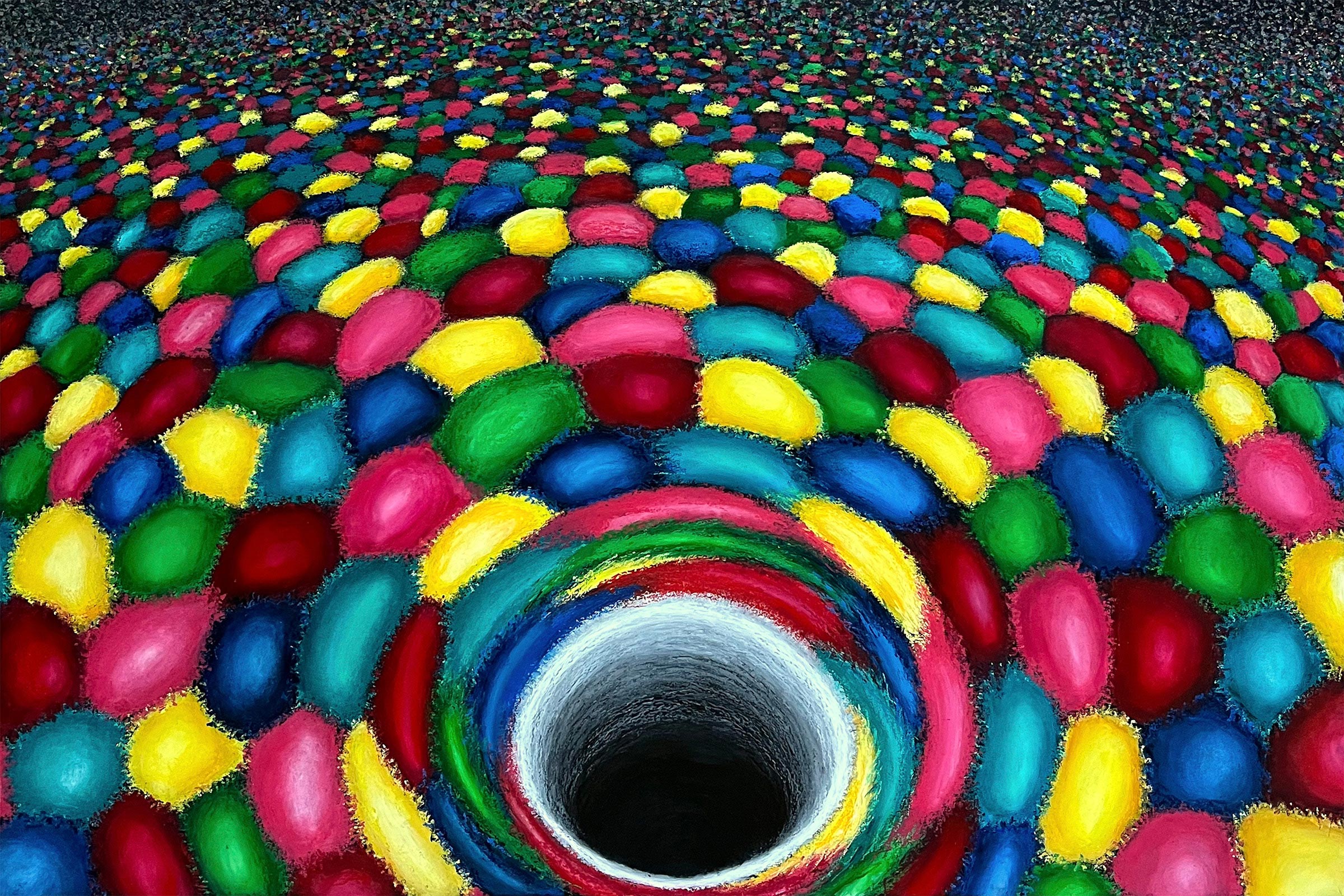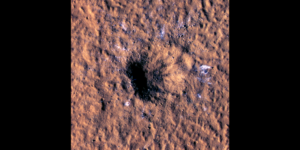Image of a primordial black hole forming in a sea of hot, colorfully charged quarks and gluons a fraction of a second after the Big Bang. Credit: Kaca Bradonich
In the first quintillionth of a second, the universe may have sprouted microscopic black holes with massive amounts of nuclear charge, according to MIT physicists.
MIT researchers suggest that primordial black holes, possibly a form of dark matter, could have formed in the first moments after Big bang and carried high levels of a nuclear property known as color charge. These supercharged black holes, despite their short existence, may have influenced the cosmology of the early universe and could explain some astronomical phenomena observed today.
Dark matter and primordial black holes
For every kilogram of matter we can see – from the phone in your hand to distant stars and galaxies – there are 5 kilograms of invisible matter seeping around us. This “dark matter” is a mysterious entity that eludes all forms of direct observation, but makes its presence felt through its invisible attraction to visible objects.
Fifty years ago, physicist Stephen Hawking proposed an idea of what dark matter might be: a population of black holes that may have formed very soon after the Big Bang. Such “primordial” black holes would not be the goliaths we find today, but rather microscopic regions of superdense matter that would have formed in the first quintillionth of a second after the Big Bang and then collapsed and scattered through space, pulling warping spacetime in ways that could explain the dark matter we know today.
Discovery of supercharged black holes
Now MIT physicists have discovered that this primordial process would also create some unexpected companions: even smaller black holes with unprecedented amounts of a nuclear-physical property known as “color charge.”
These smallest, “supercharged” black holes would be an entirely new state of matter that probably evaporated a fraction of a second after they appeared. Yet they could still affect a key cosmological transition: the time when the first atomic nuclei were forged. Physicists postulate that color-charged black holes could affect the balance of merging nuclei in a way that astronomers could one day detect with future measurements. Such an observation would conclusively point to primordial black holes as the root of all dark matter today.
“Even though these short-lived, exotic creatures aren’t around today, they could have influenced cosmic history in ways that can show up in subtle signals today,” said David Kaiser, Germeshausen Professor of the History of Science and Professor of Physics at MIT. “Within the idea that all dark matter can be explained by black holes, it gives us new things to look for.”
Kaiser and his co-author, MIT graduate student Elba Alonso-Monsalve, published their study June 6 in the journal Physical examination letters.
Time before the stars
The black holes we know and discover today are the product of stellar collapse, when the center of a massive star collapses in on itself to form a region so dense that it can bend spacetime so that everything – even light – can be caught inside. Such “astrophysical” black holes can be anywhere from a few times more massive than the Sun to many billions of times more massive.
“Primordial” black holes, in contrast, can be much smaller and are thought to have formed in a time before the stars. Before the universe had even cooked up the basic elements, let alone stars, scientists believe that pockets of ultradense, primordial matter may have accreted and collapsed to form microscopic black holes that could be so dense, to squeeze the mass of an asteroid into a region as small as a single atom. Gravitational pull from these tiny, invisible objects scattered throughout the universe could explain all the dark matter we can’t see today.
If this were the case, then what would these primordial black holes have been made of? That’s the question Kaiser and Alonso-Monsalve tackled with their new study.
“People have studied what the spread is Black hole masses would have been during that production of the early universe, but they never tied it to what kind of stuff would have gone into these black holes at the time they formed,” Kaiser explains.
Super charged rhinos
The MIT physicists first looked at existing theories about the likely mass distribution of black holes as they first formed in the early universe.
“Our realization was that there is a direct relationship between when the primordial black hole forms and with what mass it forms,” says Alonso-Monsalve. “And that time period is ridiculously early.”
She and Kaiser calculated that primordial black holes must have formed within the first quintillionth of a second after the Big Bang. This flash of time would have created “typical” microscopic black holes that were as massive as an asteroid and as small as an atom. This would also yield a fraction of exponentially smaller black holes, with the mass of a rhinoceros and a size much smaller than a single proton.
What would these primordial black holes be made of? To do this, they turned to studies investigating the composition of the early universe, and in particular to the theory of quantum chromodynamics (QCD) – the study of how quarks and gluons interact.
Quantum dynamics and black hole formation
Quarks and gluons are the basic building blocks of protons and neutrons — elementary particles that combine to forge the basic elements of the periodic table. Immediately after the Big Bang, physicists calculate, based on QCD, that the universe was extremely hot plasma of quarks and gluons, which then rapidly cool and combine to produce protons and neutrons.
The researchers found that within the first quintillionth of a second, the universe would still be a soup of free quarks and gluons that had not yet combined. Any black holes that formed during that time would have absorbed the unbound particles, along with an exotic property known as “color charge”—a state of charge carried only by uncombined quarks and gluons.
The role of color charge in black hole dynamics
“Once we understood that these black holes form in a quark-gluon plasma, the most important thing we needed to understand was how much color charge is contained in the blob of matter that will end up in a primordial black hole?” Alonso-Monsalve says.
Using QCD theory, they worked out the color charge distribution that should exist in the hot early plasma. They then compared this to the size of a region that would collapse to form a black hole in the first quintillionth of a second. It turns out that there wouldn’t have been much color charge in most typical black holes at the time, because they would have formed by absorbing a huge number of regions that had a mixture of charges, eventually resulting in a “neutral” charge.
Conclusion and future implications
But the smallest black holes would be full of color charge. In fact, they would contain the maximum amount of any kind of charge allowed for a black hole, according to the basic laws of physics. While such “extreme” black holes have been hypothesized for decades, until now no one has discovered a realistic process by which such oddities could actually form in our universe.
Professor Bernard Carr of Queen Mary University of London, an expert on the subject of primordial black holes who first worked on the subject with Stephen Hawking, described the new work as “exciting”. Carr, who was not involved in the research, said the work “shows that there are circumstances in which a small fraction of the early universe can transition into objects with an enormous amount of color charge (at least for a while), exponentially greater than what has been identified in previous QCD studies.
Supercharged black holes would evaporate quickly, but probably not until after the time when the first atomic nuclei began to form. Scientists estimate that this process began about one second after the Big Bang, which would have given the extreme black holes enough time to disrupt the equilibrium conditions that would have prevailed when the first nuclei began to form. Such perturbations could potentially affect the formation of these earliest cores in ways that may someday be observed.
“These objects may have left some exciting observational imprints,” Alonso-Monsalve reasoned. “They could change the balance between this and that, and that’s something you can start to wonder about.”
Reference: “Primordial black holes with QCD color charge” by Elba Alonso-Monsalve and David I. Kaiser, 6 Jun 2024, Physical examination letters.
DOI: 10.1103/PhysRevLett.132.231402
This research was supported in part by the US Department of Energy. Alonso-Monsalve is also supported by a fellowship from the MIT Department of Physics.



